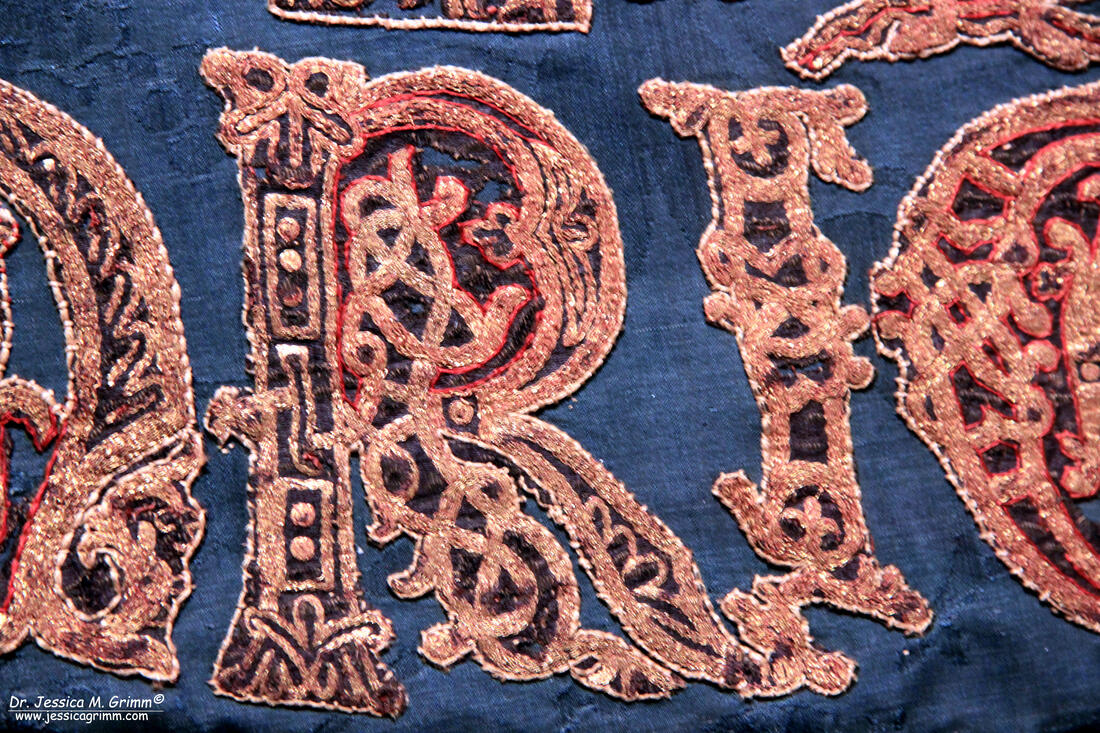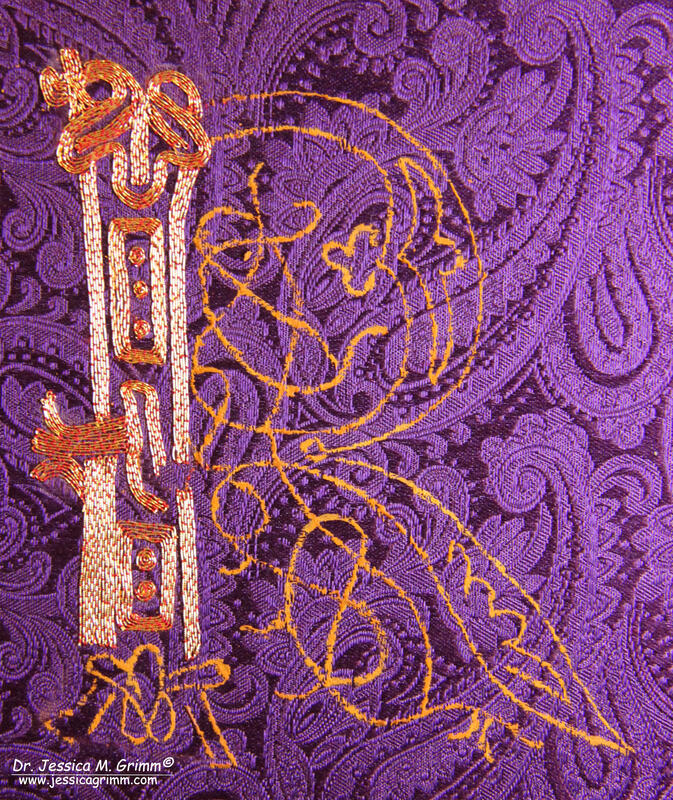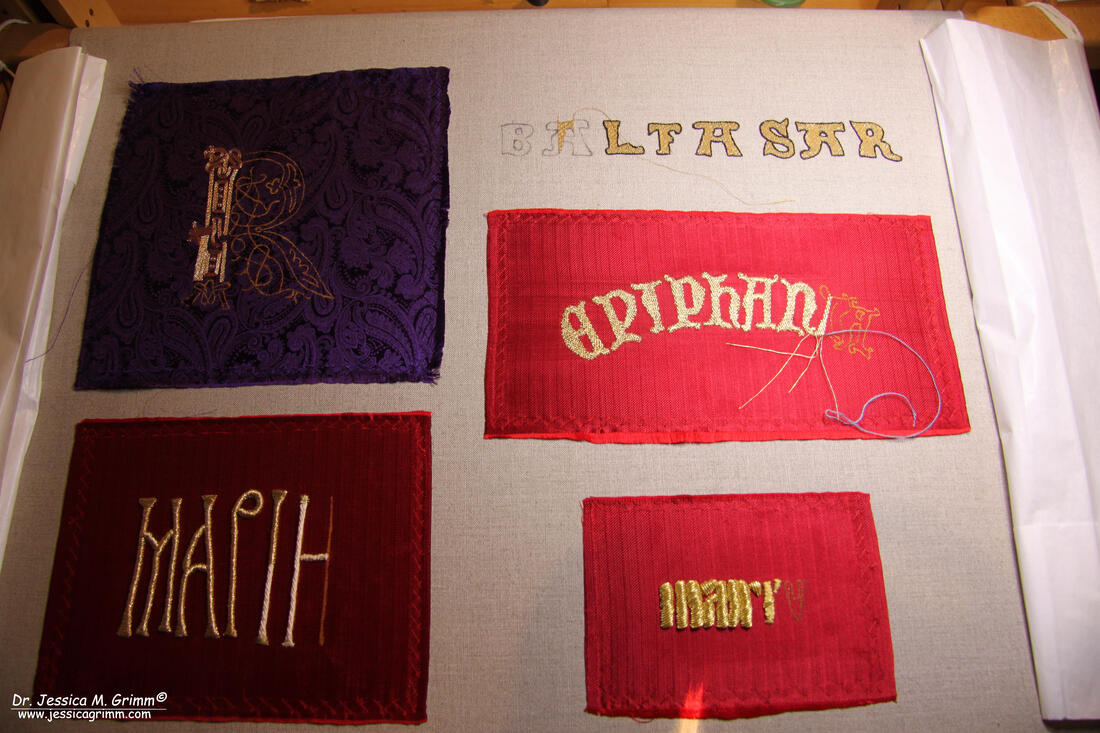|
This is the last article in the series accompanying the conference 'Über Stoff und Stein' in Munich. The other three articles can be found here: part I, part II and part III. For my last goldwork embroidery sample, I choose a letter from the Sternenmantel of Holy Roman Emperor Henry II held at Bamberg. You can read about my visit to the museum where it is housed here. As one of the conference organisers, Dr. Tanja Kohwagner-Nikolai, is also head of the research team for the embroideries held at the Diocesan Museum in Bamberg, I was able to ask very specific questions about the embroidery. I was even given a high-resolution picture of the particular letter (for obvious copyright reasons, I can't publish that picture here). Join me in my musings on recreating part of a very elaborate 'R' from a stunning piece of embroidery that's a 1000-years old. The original goldwork embroidery was worked on a dark purple samite. This is a specific twill-type weave for silk fabric which was popular in the Middle Ages. I only once had a small piece in my hand which was found during an archaeological excavation in the medieval parts of Emden in northern Germany. Samite is hard to get hold of nowadays. Czech-based company Sartor recreates historical samites for the re-enactment scene. Fortunately for my purse, they don't have a dark purple one in stock. Instead, I had a look in my fabric stash and came up with a paisley patterned silk damask. Next up was transferring the pattern. The drawing of the 'R' is very intricate and can only be transferred onto the fabric once simplified. I made a pricking of the simplified drawing and used white pounce powder for the transfer. The white dots were then connected with watered-down watercolour Raw Siena (see video above). As the drawing is so intricate, I did my utmost best to keep the paint lines as fine as possible. NB: From the high-resolution picture I could tell that the letter is 9.5 cm tall. As I worked with my original pictures and some crude maths, my copy is about a centimetre taller. The Sternenmantel has undergone major alterations since it was first stitched around AD 1020. The first major re-make took place in the 15th century when the gold embroideries were cut out from the old mantle and appliqued onto the blue silk damask we see today. The thick red and white embroidered lines along the edges of the lettering date to this re-make. The original lettering looked indeed very different. The goldthread used for the lettering is a kind of very fine passing thread. The strips of gold foil wrapped around the silk core are less than half a millimetre wide and have a near pure gold content. In comparison, most ordinary gilt goldthreads used today have a gold content of 0.3% -2%. There are about 46 goldthreads per centimetre and this makes each goldthread around 0.21 mm. This is comparable to a modern-day Stech vergoldet CS 70/80 or a smooth passing #3. The goldthread is couched down as a single thread with red silk yarn. I've used DeVere Yarns Carmine #666. There is no regular couching pattern. Although the high-resolution picture is much better than my original pictures, I still am unable to tell if the tails of the goldthreads are plunged and tied back on the reverse of the fabric or if the ends are simply cut off and secured with an extra couching stitch. It is highly likely that the answers lie beneath the thick white and red contour lines which were added in the 15th century when the goldwork was taken off the original mantle (or mantles) and appliqued onto this 'new' one. I was also told by the head of the research team that the restoration in the 20th century now makes it impossible to inspect the reverse of the embroidery. This is very unfortunate indeed, but also shows the great strides made in textile conservation since then. In my reconstruction, I did not plunge my ends in accordance with the later Gothic embroideries from the Low Countries where there was no plunging either. I know that this is a long stretch both in time and area. However, the goldthread used is so pure that it would have been far too costly to waste any of it on the back. During the conference, I had a lovely discussion with both Tanja and Dr. Holger Kempkens on who made the Sternenmantel and the other magnificent goldwork embroideries held at the Diocesan Museum Bamberg. We readily agreed that it was not noblewomen or nuns, but men in professional workshops. Probably travelling with the highly mobile imperial court. And with connections to both the Western world and the Islamic world. Modern-day professional commercial goldwork embroidery is often executed by men (for instance the cover for the Kaaba in Mecca). The first mentions in the historical records of women doing goldwork embroidery either as creators or repairers are from the 17th century in this part of the world (the situation is different in England). And then there is the embroidery itself. The couching on the lettering is done in a very specific way. Although the couching stitches are placed randomly, the goldthread is by no means laid randomly. The embroiderer made sure that this very precious thread was laid down in the most economic way with as little starts and stops as possible. This is easy to do on the straight parts, but far less easy on the 'knotty' bits. Although I stared long and hard at the picture, I found out halfway through the actual stitching that I had it wrong. In comparison, my husband needed very little time to figure out the correct 'path'. Now please don't get me wrong or accuse me of sexism, but there are things in life MOST men can do better than women and vice versa. Not ALL men or ALL women. And this is not to say that there aren't women out there that can do this job perfectly. But I get the feeling that this particular embroidery job suits men better than women. Please don't hate me. Demonstrating historical goldwork embroidery techniques to the conference delegates was very enjoyable. They were tremendously interested and had lots of questions. It is so important to get both 'head' people and 'hands' people in the same room talking to one another. Tanja's idea of doing just that for this conference was brilliant and I certainly hope that it will get copied like mad by others. Literature
Baumgärtel-Fleischmann, R. 1983. Diözesanmuseum Bamberg ausgewählte Kunstwerke, Bayerische Verlagsanstalt Bamberg. ISBN 3-87052-380-8. Grimm, J.M., 2021. A hands-on approach - Epigraphy in medieval textile art, in: Kohwagner-Nikolai, T., Päffgen, B., Steininger, C. (Eds.), Über Stoff und Stein. Knotenpunkte von Textilkunst und Epigraphik. Harrassowitz, Wiesbaden, pp. 141–147. Kohwagner-Nikolai, T., S. Ruß & U. Drewello, 2016. Goldgestickte Vergangenheitsinszenierung, Restauro 5, pp. 48-53. Kohwagner-Nikolai, T., 2014. O Decus Europae Cesar Heinrice? Die Saumumschrift des sogennanten Bamberger Sternenmantels Kaiser Heinrichs II., Archiv für Diplomatik, Schriftgeschichte, Siegel- und Wappenkunde 60, pp. 135-1646. P.S. Did you like this blog article? Did you learn something new? When yes, then please consider making a small donation. Visiting museums and doing research inevitably costs money. Supporting me and my research is much appreciated ❤!
7 Comments
Ann Bernard
16/2/2020 23:31:22
Jessica, Thank you. Very interesting. Ann
Reply
Kristi Nowak
17/2/2020 15:58:34
This is particularly interesting for an "old" medievalist!! Your blogs are always MOST interesting - thank you!!
Reply
Vic
9/4/2021 21:01:26
Sigh. How disappointing to see such interesting analysis and then the old "men just do this better than women" chestnut. And given the massive amount of elaborate Ottonian work in nunneries (inscribed, frequently, with [woman's name fecit]), I think your experts are also reaching when they insist that men must have done the original work. We don't know.
Reply
9/4/2021 21:11:27
Thank you for your comment, Vic. Not sure if you are an embroiderer yourself, but from your comment I guess you are not. The Ottonian embroideries you mention are of a very different nature 1) different materials, 2) different techniques and 3) not done in a professional workshop. You are comparing apples with pears here :). Additionally, we have lots of written sources for the later medieval period from continental Europe that state male embroiderers for the goldwork embroidery, but never women (they do embroider, just not goldwork). In addition, modern non-western goldwork embroiderers are too.
Reply
Your comment will be posted after it is approved.
Leave a Reply. |
Want to keep up with my embroidery adventures? Sign up for my weekly Newsletter to get notified of new blogs, courses and workshops!
Liked my blog? Please consider making a donation or becoming a Patron so that I can keep up the good work and my blog ad-free!
Categories
All
Archives
July 2024
|
Contact: info(at)jessicagrimm.com
Copyright Dr Jessica M. Grimm - Mandlweg 3, 82488 Ettal, Deutschland - +49(0)8822 2782219 (Monday, Tuesday, Friday & Saturday 9.00-17.00 CET)
Impressum - Legal Notice - Datenschutzerklärung - Privacy Policy - Webshop ABG - Widerrufsrecht - Disclaimer
Copyright Dr Jessica M. Grimm - Mandlweg 3, 82488 Ettal, Deutschland - +49(0)8822 2782219 (Monday, Tuesday, Friday & Saturday 9.00-17.00 CET)
Impressum - Legal Notice - Datenschutzerklärung - Privacy Policy - Webshop ABG - Widerrufsrecht - Disclaimer









 RSS Feed
RSS Feed